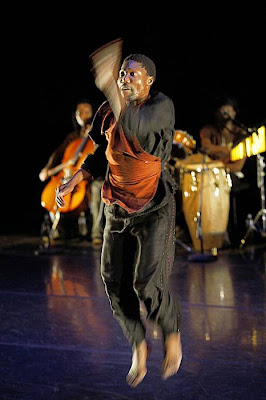By Ann Murphy
Contra Costa Times Correspondent
Posted: 05/24/2010 05:00:43 PM PDT
Updated: 05/26/2010 10:43:13 AM PDT
When the dance community first heard that arts curator Andrew Wood was laying big plans for a summer arts festival in San Francisco eight years ago, there was an audible sigh of relief. Someone finally had read the collective mind: if every provincial European town, from the exquisite Rovereto in Northern Italy to the stark white palaces of Avignon in the south of France, could mount important summer festivals, why couldn't San Francisco?

But mounting an arts festival is a massive undertaking, even in prosperous times. When the economy tanks, it seems either fatally naive or wonderfully visionary.
Now entering his seventh festival year, Wood is closer to the upbeat visionary, although his hyperactive, lanky frame and mile-a-minute patter exemplify a man hard at work to keep the dream alive. Wood believes if he juxtaposes local and nonlocal American artists with groups from outside the United States, we might see our own artists in fresh ways while being exposed to new material. And being placed in context with work from other countries gives local performers a chance to expand their own sense of the possible.
"Most of our audiences are artists who have told us that they don't need to see the Merce Cunningham Company for the 30th time," Wood said by phone. "They need to see something new, to see companies that perhaps haven't figured out the answers but are asking the same questions."
To that end, the San Francisco International Arts Festival plucks work from what Wood describes as "a whole world" of performance around the globe. It showcases some of it alone or puts it in collaboration with experienced local or U.S. artists to create new, provocative fusions. And each year the festival is able to build off the experiments of the year before, with the result that it celebrates Northern California's regional cultural diversity and nurtures cross-cultural and cross-genre experimentation that prods performance out of customary forms. This kind of daring isn't always successful, but no one can say it isn't exciting.
One of the more intriguing offerings this year is the genre-bending France-based company run by Vietnamese-French circus performer Xavier Kim. He brings his A.K.Y.S. (Always Keep Your Smile) troupe to Fort Mason this weekend to acrobatically tell the story of independent contractors roped to the high-tech industry.
Butoh with poetry
Another is a complex collaboration Thursday through Sunday between butoh dance master Ko Murobushi and local hybrid poet-performer Shinichi Iova-Koga, which aims to reach into our dream states.

Their premiere, "The Crazy Cloud Collection," combines Dada-like play and the curious paradoxes of butoh in an investigation of what they describe as the collision of a 15th-century monk's encounter with modernity.
DETAILS: May 28-29, 8 p.m., May 30, 5 p.m., $20 (advance), $25. Z Space at Theater Artaud, 450 Florida St., S.F.
On Saturday and Sunday,
 the SFIAF presents local ballet talent Amy Seiwert and Frederick Weiss of Nuremburg, Germany, whose video motion-sensing technology, im'ij're (imagery), enables Seiwert and her company to explore what it means to cancel differences in a new work titled "White Noise."
the SFIAF presents local ballet talent Amy Seiwert and Frederick Weiss of Nuremburg, Germany, whose video motion-sensing technology, im'ij're (imagery), enables Seiwert and her company to explore what it means to cancel differences in a new work titled "White Noise."DETAILS: May 29, 9 p.m., May 30, 7 p.m., $25 (reserved), $20 in advance. Herbst Pavilion, Fort Mason Center S.F.
A birth dance
Company Prototype Status takes technology somewhere very different in "Marvin (biomechanical birth of an android)." Choreographed by Jasmine Morand and performed by David N. Russo, "Marvin" is a 35-minute birth dance of an artificially intelligent android with a name that means "friend of the sea."
DETAILS: May 28, 9 p.m., May 29, 7 p.m., May 30, 4 p.m. $20 (advance), $25 general. Z Space at Theater Artaud, 450 Florida St., S.F.
A dozen other events run concurrently this weekend, from a performed improvisation by maverick Keith Hennessey to a performance of ancient and contemporary Chinese music by renowned guqin (a 7-stringed zither) player Wang Fei. For tickets to all the above events and complete festival details, call 800-838-3006 or visit www.sfiaf.org.
Cultures on display
As soon as the SFIAF packs its bags, the granddaddy of local dance festivals, the Ethnic Dance Festival, swings into action. Where the artists of the SFIAF draw inspiration from varied cultures and blend them in novel ways, the Ethnic Dance Festival showcases the dances of the cultures themselves, whether in their evolving, immigrant form or as indigenous art brought by newcomers to the United States.
Beginning June 5 and running each weekend throughout the month, the festival showcases Korean, Hawaiian, Indian, African, Uzbeki, Mexican, Chinese, Cambodian, Bolivian, Puerto Rican and Transylvanian dances, among many other dance forms, in what has become a world-renowned display of both the enduring nature of dance culture and its shapeshifting character over time.
Each show presents a succession of relatively short works, arranged in serious, variety-show fashion, not only keeping audiences engaged, but allowing us to see the common links between radically different ways of moving.
DETAILS: June 5-6, 12-13, 19-20, 26-27, Saturdays at 2 and 8 p.m., Sun at 2 p.m., $22-$44, Palace of Fine Arts Theatre, 3301 Lyons St., S.F. 415-567-6642, www.worldartswest.org.

